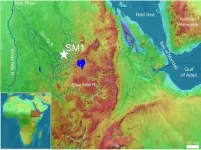(Press-News.org) A millimeter-scale, chip-less and battery-less implant can wirelessly monitor a series of parameters within your body and communicate with a wearable device attached on the skin. In a recent study published in the journal Science Advances, researchers from Peking University have unveiled a miniaturized implantable sensor capable of health monitoring without the need of transcutaneous wires, integrated circuit chips, or bulky readout equipment, thereby reducing infection risks, improving biocompatibility, and enhancing portability.
Han Mengdi from Peking University, the lead researcher of this project, expressed optimism about the implications of this innovation, “Our miniaturized system presents exciting possibilities for advancing health monitoring. By inserting a tiny magnetic implant into the body, it can provide a rich set of real-time data related to your health status. We aim to use such magnetic implants to enhance the way we monitor and manage health.”
In experiments conducted on rat models, the system showed promising capabilities in measuring critical parameters, such as cerebrospinal fluid viscosity, intracranial pressure, and glucose levels. This compact system holds potential for continuous, wireless monitoring of a wide range of biophysical and biochemical conditions within living organisms.
“Beyond monitoring signals in the brain, the versatility of our system can be further extended,” said Wan Ji, a Ph.D. Student in Han lab and co-first author on the paper. “It can be deployed to monitor a wide array of vital signs and parameters across various body regions, from cardiovascular indicators like blood pressure and viscosity to dental and orthopedic forces, abdominal pressure, and even molecular and cellular distributions within the body.” This opens up unprecedented possibilities for diagnosing, treating, and managing a plethora of acute and chronic diseases.
“This system comprises millimeter-scale, chip-less, and battery-less magnetic implants paired with a seamlessly integrated wearable device. Unlike traditional methods, the wearable device has the capability to initiate a damped vibration in the magnetic implants, subsequently capturing their ensuing vibration motions wirelessly,” saidNie Zhongyi, a Ph.D. Student in Han lab and co-first author on the paper. “These motions serve as precise indicators of the biophysical conditions surrounding the implants and the concentration of specific biochemicals, depending on surface modifications.”
“While the tiny magnetic implants show advanced capabilities in wireless biosensing, challenges lie ahead,” Han Mengdi said, “Long-term stability and biocompatibility of the magnetic implants require further investigation and improvement. Nevertheless, with ongoing advancements in technology and deeper exploration of research, these challenges are expected to be addressed effectively.”
These tiny magnetic implants not only advance the development of health monitoring technology, but also signify a potential transformation in the medical field. With further development, this technology could potentially contribute to an enhanced standard of healthcare, empowering individuals to more proactively manage their well-being with greater ease and accuracy.
The study, “Millimeter-scale magnetic implants paired with a fully integrated wearable device for wireless biophysical and biochemical sensing,” was supported by the National Natural Science Foundation of China (No. 62104009); the Emerging Engineering Interdisciplinary Project, Peking University, the Fundamental Research Funds for the Central Universities; and Peking Nanofab Laboratory.
END
Tiny magnetic implants enable wireless healthcare monitoring
2024-03-20
ELSE PRESS RELEASES FROM THIS DATE:
New study suggests that while social media changes over decades, conversation dynamics stay the same
2024-03-20
Published in Nature, a new study has identified recurring, ‘toxic’ human conversation patterns on social media, which are common to users irrespective of the platform used, the topic of discussion, and the decade in which the conversation took place.
In particular, the study suggests that prolonged conversations on social media are more prone to toxicity, and polarisation, when divergent viewpoints from debate lead to an escalation of online disagreement.
Contrary to the prevailing assumption, the study suggests that toxic interactions do not deter users from engagement, they actively participate in conversations. It also suggests that toxicity ...
Study finds non-immune brain cells can acquire immune memory, may drive CNS pathologies like multiple sclerosis
2024-03-20
Immunological memory — the ability to respond to a previously encountered antigen, or foreign substance, with greater speed and intensity on re-exposure is a hallmark of adaptive immunity. Innate immune cells also develop metabolic and epigenetic memories that boost their responses, but it was previously unknown if non-immune cells like astrocytes, which interact with immune cells and contribute to inflammation in the central nervous system (CNS), acquire aspects of immune memory of encountering ...
Canada should ban all unhealthy food marketing children may be exposed to
2024-03-20
Quebec City, March 20, 2024–Canada should ban marketing of unhealthy foods wherever children may be exposed, whether on TV, social media or billboards. This is one of the main conclusions of a Canada-wide study involving more than fifty food and nutrition experts made public today by a team from Université Laval's Faculty of Agriculture and Food Sciences.
The study, conducted as part of a research program funded by the Canadian Institutes of Health Research, also recommends better funding ...
The 7th World Conference on Targeting Phage Therapy, taking place in Malta in 2024, will showcase current developments in phage therapy and offer strategic insights into its future directions
2024-03-20
The 7th World Conference on Targeting Phage Therapy 2024 is set to take place on June 20-21 at the Corinthia Palace Malta, introducing the latest advancements within the field of phage research and therapy.
Robert T. Schooley, M.D., Professor of Medicine at the University of California, San Diego, and Co-Director of the Center for Innovative Phage Applications and Therapeutics, will lead the discourse, presenting insights and strategies essential to Phage Therapy in his talk titled "Phage Therapeutics 2024: Essential Translational Research Components for Clinical Trials."
Agenda at a Glance
Day One: will focus on Phages, Hosts & Microbiome, exploring ...
Companies reluctant to pay extra to confirm suppliers’ sustainability claims
2024-03-20
Many companies proclaiming ethical credentials resist paying a premium to test their suppliers’ sustainability claims, new research suggests.
A team from Bayes Business School (formerly Cass), City, University of London, studied responses from 234 managers with procurement decision-making powers.
While buyers’ purchasing decisions are not solely price-driven, the team found, they are often happy to accept suppliers’ reassurances about sustainability rather than pay a premium for third party verification. Despite accepting ...
Deep Earth electrical grid mystery solved
2024-03-20
To “breathe” in an environment without oxygen, bacteria in the ground beneath our feet depend upon a single family of proteins to transfer excess electrons, produced during the “burning” of nutrients, to electric hairs called nanowires projecting from their surface, found by researchers at Yale University and NOVA School of Science and Technology, NOVA University Lisbon (NOVA-FCT).
This family of proteins in essence acts as plugs that power these nanowires to create a natural electrical ...
Metformin during pregnancy affects the brain development in offspring mice
2024-03-20
With the rise in gestational diabetes and metabolic disorders during pregnancy, metformin is also being prescribed more frequently. Although it is known that the oral antidiabetic agent can cross the placental barrier, the impacts on the brain development of the child are largely unknown. An interdisciplinary research team from the German Institute of Human Nutrition Potsdam-Rehbrücke (DIfE) have now been able to demonstrate in a mouse model that although metformin has positive effects in pregnant animals, it does not in the offspring. The results were published in the specialist journal ‘Molecular ...
Exposure to tobacco before birth significantly increased risk of Type 2 diabetes in adults
2024-03-20
Research Highlights:
Exposure to tobacco before birth and beginning smoking during childhood or adolescence were significantly associated with the development of Type 2 diabetes in adulthood, according to a study of nearly half a million adults in the UK Biobank.
Among those exposed to tobacco before birth or who began smoking during childhood or adolescence, participants who had a genetic predisposition to develop Type 2 diabetes and started smoking in childhood or adolescence had the highest risk of developing Type 2 diabetes.
Embargoed until 10:30 a.m. ...
In flies, a single brain cell can drive multiple movements of the body
2024-03-20
NEW YORK, NY — Motor neurons are the cells the brain uses to command muscles to act. Scientists typically thought of them as simple connections, much like the cables that link computers with their accessories. Now, in fly studies, researchers at Columbia's Zuckerman Institute have discovered that single motor neurons can each direct an insect’s body to move in far more complex ways than previously thought.
The findings were published in Nature on March 20.
"This is one of the first times scientists have analyzed in 3D what single motor neurons do ...
Toba supereruption unveils new insights into early human migration
2024-03-20
Modern humans dispersed from Africa multiple times, but the event that led to global expansion occurred less than 100,000 years ago. Some researchers hypothesize that dispersals were restricted to “green corridors” formed during humid intervals when food was abundant and human populations expanded in lockstep with their environments. But a new study in Nature, including ASU researchers Curtis Marean, Christopher Campisano, and Jayde Hirniak, suggests that humans also may have dispersed during arid intervals along “blue highways” created by seasonal rivers. Researchers also found evidence of cooking and stone tools that represent the oldest evidence of archery.
Working ...



